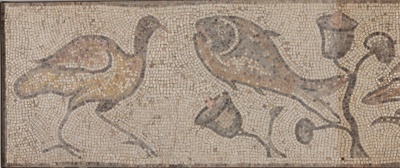< Collection search
< Collection highlights
From:UC Teece Museum of Classical Antiquities
Name/TitleFloor Mosaic
About this objectMosaics are made up of pieces called tesserae, which are arranged to create a pattern or picture. A tessera (Latin for tile or cube) can be made of stone, ceramic, glass or similar hard objects, and pebbles were used in early examples. The tesserae of this floor mosaic are made of cut stone set into mortar.
Mosaics appear to have developed from the use of spreading harder material such as pebbles onto dirt floors to make them more durable. Mesopotamians and Greeks turned this into an artform by creating geometric patterns and designs with the stones, but the peak of ancient mosaics was in the wealthy Roman provinces, especially in Africa and Syria.
By the 5th Century CE, the dominant imagery in Syrian mosaics was animals, often shown standing or walking in minimalist landscapes. River scenes like this mosaic were also very popular. These scenes are often referred to as Nilotic scenes, as they show the plants and wildlife of the Nile in Egypt, a subject very popular with Romans who would decorate their villas with these scenes to show knowledge of the outside world.
This section has a river scene with water-birds, fish and water-lilies. The bird to the right has a snake in its mouth. The elements have a double row of tesserae around them before becoming more random. The inner parts of the birds and fish are in pink, orange-brown and white, with grey-black for the major internal features. The lilies use a combination of grey-black and white to achieve a three-dimensional effect, with red and pink for the flowers themselves. The tesserae have been cut from rods to create roughly square-shaped tiles approximately 1cm by 1cm.
There are traces of a grey border running around the four sides of the preserved area. This border, along with the size of the piece, suggest that it came from the border of a large room like a church, or possibly filled the threshold between rooms in a house.
There is evidence of some repair or retouching on the right side, which has been varnished with modern product.
Date Made5th-6th Century CE
PeriodByzantine
Place MadeSyria
Place NotesThe style suggests the piece is from Syria
Medium and MaterialsStone; Mortar
Style and IconographyAnimal art
Style and IconographyRoman
TechniqueMosaic (process)
TechniqueOpus tessellatum (process)
MeasurementsHeight 670mm (preserved); Width 2820mm (preserved)
Subject and Association KeywordsAnimals in art
Subject and Association KeywordsBirds in art
Subject and Association KeywordsNature in art
Named CollectionThe James Logie Memorial Collection, University of Canterbury, New Zealand
Credit LineDonated by Graham Geddes, 2000.
Object TypeMosaics
Object number188.00
Copyright LicenceAll rights reserved


